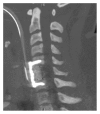Fatal Vertebral Artery Injury in Penetrating Cervical Spine Trauma
- PMID: 26640731
- PMCID: PMC4659960
- DOI: 10.1155/2015/571656
Fatal Vertebral Artery Injury in Penetrating Cervical Spine Trauma
Erratum in
-
Corrigendum to "Fatal Vertebral Artery Injury in Penetrating Cervical Spine Trauma".Case Rep Neurol Med. 2017;2017:3861804. doi: 10.1155/2017/3861804. Epub 2017 Mar 12. Case Rep Neurol Med. 2017. PMID: 28386494 Free PMC article.
Abstract
Study Design. This case illustrates complications to a vertebral artery injury (VAI) resulting from penetrating cervical spine trauma. Objectives. To discuss the management of both VAI and cervical spine trauma after penetrating gunshot wound to the neck. Summary of Background Data. Vertebral artery injury following cervical spine trauma is infrequent, and a unilateral VAI often occurs without neurologic sequela. Nevertheless, devastating complications of stroke and death do occur. Methods. A gunshot wound to the neck resulted in a C6 vertebral body fracture and C5-C7 transverse foramina fractures. Neck CT angiogram identified a left vertebral artery occlusion. A cerebral angiography confirmed occlusion of the left extracranial vertebral artery and patency of the remaining cerebrovascular system. Following anterior cervical corpectomy and stabilization, brainstem infarction occurred and resulted in death. Results. A fatal outcome resulted from vertebral artery thrombus propagation with occlusion of the basilar artery triggering basilar ischemia and subsequent brainstem and cerebellar infarction. Conclusions. Vertebral artery injury secondary to cervical spine trauma can lead to potentially devastating neurologic sequela. Early surgical stabilization, along with anticoagulation therapy, contributes towards managing the combination of injuries. Unfortunately, despite efforts, a poor outcome is sometimes inevitable when cervical spine trauma is coupled with a VAI.
Figures




References
LinkOut - more resources
Full Text Sources
Other Literature Sources
Miscellaneous

